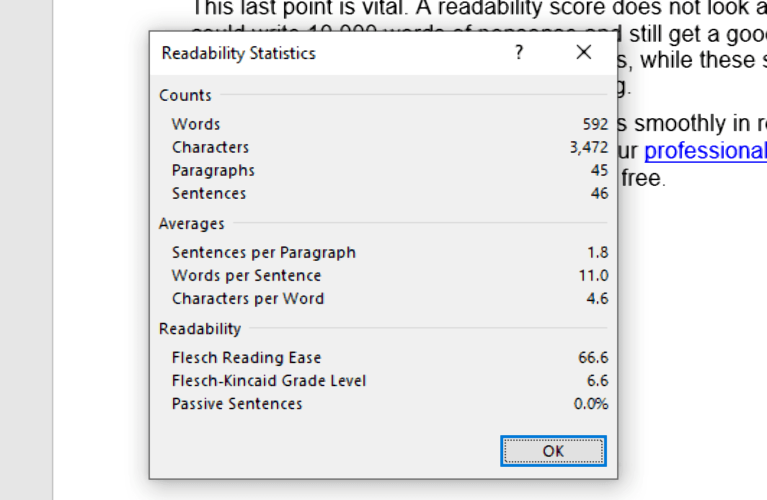-
3-minute read
-
19th July 2020
What Are Readability Scores?
Readability scores tell you how easy a text is to read. But how do these scores work? And can they help you improve your writing? In this post, we answer your questions and look at your options.
What Are Readability Scores?
Readability refers to how easy text is to understand. And a readability test is an algorithm that scores a text on its readability.
These scores are usually based on the number and length of the words and sentences in the text. In most cases, they will suggest a reading level based on the school year, age, or status of the person who is reading it.
The Flesch–Kincaid test, for example, gauges reading levels based on educational level. This ranges from fifth grade (10–11 years old) through to college graduates and professionals. You can see these scores below:
|
Score |
School Level |
Notes |
|
100–90 |
5th Grade (10–11 years old) |
Very easy to read. |
|
90–80 |
6th Grade (11–12 years old) |
Easy to read. |
|
80–70 |
7th Grade (12–13 years old) |
Quite easy to read. |
|
70–60 |
8th and 9th Grade (13–15 years old) |
Plain English. Easy to read for most people. |
|
60–50 |
10th to 12th Grade (15–18 years old) |
Quite difficult to read. |
|
50–30 |
Undergraduate students |
Difficult to read. |
|
30–10 |
College graduates |
Very difficult to read. |
|
10–0 |
Postgraduates/Professionals |
Extremely difficult to read. |
Find this useful?
Subscribe to our newsletter and get writing tips from our editors straight to your inbox.
Subscribe to Beyond the Margins and get your monthly fix of editorial strategy, workflow tips, and real-world examples from content leaders.
Why Use a Readability Test?
Many word processors, including Microsoft Word, feature a tool to check the readability of a document. You can also download dedicated readability test software or use an online tool to check a text.

But why would you want to use one? Especially if you’re a confident writer?
Well, every writer needs to write at a level their audience can understand. Readability tests can help you do this by giving you an objective score for how easy your work is to follow. In addition, they can identify issues in your writing that you may miss otherwise, such as excessive use of passive voice.
As such, readability scores can give you a sense of whether your work is suitable for its intended audience, as well as highlighting bad writing habits. But are readability scores trustworthy? And how do they compare to having your work proofread by an expert? Let’s take a look.
Are Readability Scores Reliable?
Readability scores can provide helpful information that you can use to improve your writing, but there are some clear shortcomings:
- Different readability tests may produce different scores for the same texts based on their algorithms. As the formulas differ, so do the results.
- The scales readability tests use may be difficult to interpret or apply in real life (e.g., depending on their backgrounds and interests, some people will score better with certain texts than with others).
- Readability tests do not take account of the style, context, or meaning of a text. They are simply mechanical scores based on pre-set criteria.
This last point is vital. A readability score does not look at what a text means. You could write 10,000 words of nonsense and still get a good readability score as long as you used short, simple sentences! Thus, while these scores can be helpful for writers, they do not guarantee good writing.
To get a sense of whether your work reads smoothly in real life, you still need to ask a human editor or proofreader. And with our professional services, you can be sure your work will be clear, concise, and error free.




